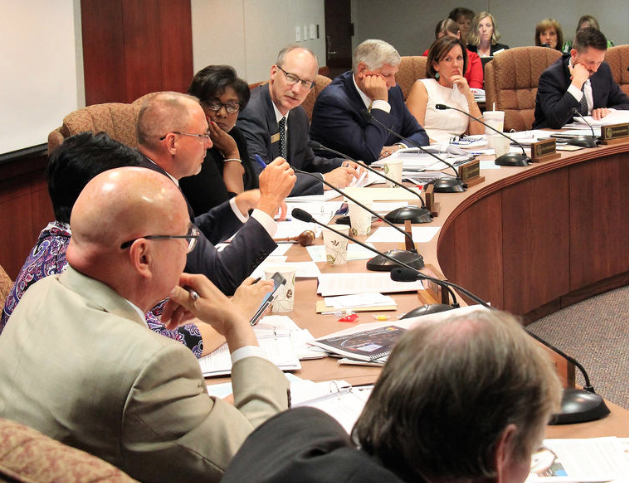By CELIA LLOPIS-JEPSEN
The cost of higher education in Kansas continued to swell this week, carrying on a long-running trend in which universities rely increasingly on tuition and fees to operate.

CELIA LLOPIS-JEPSEN / KANSAS NEWS SERVICE
This fall, a full-time semester at the University of Kansas will cost nearly $2,000 more than a decade earlier. The increase at Kansas State University has been similar.
Also over the last decade, the state’s spending per student at Kansas Board of Regents universities has slid.
Board members expressed reluctance to approve the latest round of tuition hikes during their meetings this week — and a few voted against them.
“It’s really heartbreaking to do this,” Regents Chairwoman Zoe Newton said of the increases ranging between 2.5 percent and 2.9 percent for the six state universities in the regents system. “I would hope it’s not going to just keep going up and up.”
In hours of discussion and deliberation this week, the regents worried about hindering would-be first-generation college students — a group that public universities have been courting amid ambitious goals to boost the rate of Kansans who obtain higher education degrees by 2020.
The regents wondered whether the burgeoning cost of postsecondary education makes sense in light of the salaries that many graduates can expect to earn in professions like teaching and nursing.
A Kansas Department of Labor survey put the average starting salary for an elementary teacher in Kansas around $35,500 in 2015. For a registered nurse it was about $43,300.
Regent Ann Brandau-Murguia, a resident of the Argentine neighborhood in Kansas City, Kan., was among those on the board who called for lower increases than were ultimately approved.
“I see every day the challenges that low-income families experience,” she said, “just with daily quality of life issues, let alone trying to overcome the hurdles and the stumbling blocks to get into higher education.”
But Kansans who head to college today do so in an environment where regents universities depend more on tuition and fees than state appropriations to pay the bills.

Source: Kansas Board of Regents. Dollars are adjusted for inflation.- CLICK TO ENLARGE
That has been the case since 2012, and the gap has steadily widened. In 2016, tuition and fees provided more than $9,600 per student and the state general fund provided about $7,100. A decade ago, tuition and fees brought in $6,300 per student and the state put in about $9,600.

